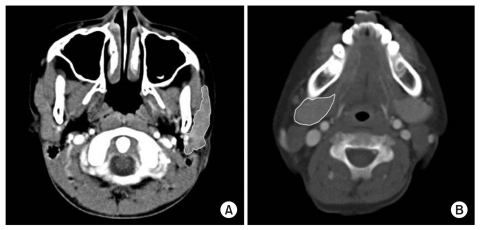Ann Rehabil Med.
2011 Oct;35(5):636-640. 10.5535/arm.2011.35.5.636.
Effect of Botulinum Toxin Type A on Morphology of Salivary Glands in Patients with Cerebral Palsy
- Affiliations
-
- 1Department of Rehabilitation Medicine, Dae-gu Fatima Hospital, Deagu 701-600, Korea. naftacho@hanmail.net
- KMID: 2267224
- DOI: http://doi.org/10.5535/arm.2011.35.5.636
Abstract
OBJECTIVE
To investigate the effect of botulinum toxin type A (BTXA) on drooling and the morphologic change of the salivary gland in patients with cerebral palsy. METHOD: Eight cerebral palsy patients suffering from severe drooling participated in this study. BTXA was injected into both submandibular and parotid glands under intravenous sedation and with ultrasound guidance (1 unit/gland/kg: maximum 100 units) in an outpatient or inpatient procedure. The severity of drooling was measured before injection and 3 weeks after injection using the Teacher Drooling Scale, the Drooling Score-severity, frequency and the Visual Analog Scale. To investigate the morphologic change of the salivary glands, the size of salivary glands were measured before injection and 3 weeks after injection using computed tomography of the neck. The measurement values were analyzed by Wilcoxon signed rank test.
RESULTS
Statistically significant improvements were shown in all three parameters for assessing the severity of drooling after BTXA injections (p<0.05). Size of the salivary glands were significantly decreased at 3 weeks after BTXA injection (p<0.05).
CONCLUSION
Salivary gland injection with BTXA could be a useful treatment method to reduce drooling in patients with cerebral palsy and decreased size of salivary glands may partially explain the mechanism.
MeSH Terms
Figure
Cited by 1 articles
-
The Correlation Between Clinical Characteristics and Radionuclide Salivagram Findings in Patients With Brain Lesions: A Preliminary Study
Donghwi Park, Seung Beom Woo, Dae Hee Lee, Kwang Jae Yu, Ju Young Cho, Jong Min Kim, Zeeihn Lee
Ann Rehabil Med. 2017;41(6):915-923. doi: 10.5535/arm.2017.41.6.915.
Reference
-
1. Jongerius PH, van Hulst K, vanden Hoogen FJ, Rotteveel JJ. The treatment of posterior drooling by botulinum toxin in a child with cerebral palsy. J Pediatr Gastroenterol Nutr. 2005; 41:351–353. PMID: 16131993.
Article2. Bhatia KP, Munchau A, Brown P. Botulinum toxin is a useful treatment in excessive drooling in saliva. J Neurol Neurosurg Psychiatry. 1999; 67:697. PMID: 10577041.3. Harris SR, Purdy AH. Drooling and its management in cerebral palsy. Dev Med Child Neurol. 1987; 29:807–811. PMID: 3319742.
Article4. van der Burg JJ, Jongerius PH, van Limbeek J, van Hulst K, Rotteveel JJ. Social interaction and self-esteem of children with cerebral palsy after treatment for severe drooling. Eur J Pediatr. 2006; 165:37–41. PMID: 16172877.
Article5. Gisel EG, Applegate-Ferrante T, Benson J, Bosma JF. Oral-motor skills following sensorymotor therapy in two groups of moderately dysphagic children with cerebral palsy: aspiration vs nonaspiration. Dysphagia. 1996; 11:59–71. PMID: 8556880.6. Teymoortash A, Sommer F, Mandic R, Schulz S, Bette M, Aumuller G, Werner JA. Intraglandular application of botulinum toxin leads to structural and functional changes in rat acinar cells. Br J Pharmacol. 2007; 152:161–167. PMID: 17618309.
Article7. Coskun BU, Savk H, Cicek ED, Basak T, Basak M, Dadas B. Histopathological and radiological investigations of the influence of botulinum toxin on the submandibular gland of the rat. Eur Arch Otorhinolaryngol. 2007; 264:783–787. PMID: 17285331.
Article8. Banerjee KJ, Glasson C, O'Flaherty SJ. Parotid and submandibular botulinum toxin A injections for sialorrhoea in children with cerebral palsy. Dev Med Child Neurol. 2006; 48:883–887. PMID: 17044954.
Article9. Heo MS, Lee SC, Lee SS, Choi HM, Choi SC, Park TW. Quantitative analysis of normal major salivary glands using computed tomography. Oral Surg Oral Med Oral Pathol Oral Radiol Endod. 2001; 92:240–244. PMID: 11505274.
Article10. Tahmassebi JF, Curzon ME. Prevalence of drooling in children with cerebral palsy attending special schools. Dev Med Child Neurol. 2003; 45:613–617. PMID: 12948328.
Article11. Ekedahl C. Surgical treatment of drooling. Acta Otolaryngol. 1974; 77:215–220. PMID: 4819034.
Article12. Park HW, Sim YJ, Bang MS. A survey of drooling in children with cerebral palsy. J Korean Acad Rehabil Med. 2007; 31:535–540.13. Jongerius PH, van Tiel P, van Limbeek J, Gabrels FJM, Rotteveel JJ. A systematic review for evidence of efficacy of anticholinergic drugs to treat drooling. Arch Dis Child. 2003; 88:911–914. PMID: 14500313.
Article14. Pena AH, Cahill AM, Gonzalez L, Baskin KM, Towbin RB. Botulinum toxin A injection of salivary glands in children with drooling and chronic aspiration. J Vasc Interv Radiol. 2009; 20:368–373. PMID: 19157908.
Article15. Bachrach SJ, Walter RS, Trzcinski K. Use of glycopyrrolate and other anticholinergic medication for sialorrhea in children with cerebral palsy. Clin Pediatr (Phila). 1998; 37:485–490. PMID: 9729704.16. Bushara KO. Sialorrhea in amyotrophic lateral sclerosis: a hypothesis of a new treatment botulinum toxin A injections of the parotid glands. Med Hypotheses. 1997; 48:337–339. PMID: 9160288.17. Savarese R, Diamond M, Elovic E, Millis SR. Intraparotid injection of botulinum toxin A as a treatment to control sialorrhoea in children with cerebral palsy. Am J Phys Med Rehabil. 2004; 83:304–311. PMID: 15024333.18. Jongerius PH, Rotteveel JJ, van den Hoogen F, Joosten F, van Hulst K, Gabreels FJ. Botulinum toxin A: a new option for treatment of drooling in children with cerebral palsy. Presentation of a case series. Eur J Pediatr. 2001; 160:509–512. PMID: 11548191.
Article19. Suskind DL, Tilton A. Clinical study of botulinum-A toxin in the treatment of sialorrhea in children with cerebral palsy. Laryngoscope. 2002; 112:73–81. PMID: 11802042.
Article20. Jongerius PH, Joosten F, Hoogen FJ, Gabreels FJ, Rotteveel JJ. The treatment of drooling by ultrasoundguided intraglandular injections of botulinum toxin type A into the salivary glands. Laryngoscope. 2003; 113:107–111. PMID: 12514392.
Article
- Full Text Links
- Actions
-
Cited
- CITED
-
- Close
- Share
- Similar articles
-
- Effects of Botulinum Toxin A Injection into Salivary Glands of Patients with Brain Lesion Suffering from Posterior Drooling
- Electrophysiological Changes after Botulinum Toxin Type A in Children with Cerebral Palsy
- A Case of Drooling during Sleep Treated with Wharton's Duct Relocation
- Effects of Botulinum Toxin A Treatment in Cerebral Palsy
- The Effect of Botulinum Toxin on an Iatrogenic Sialo-Cutaneous Fistula


